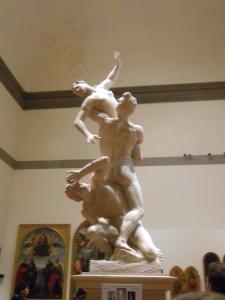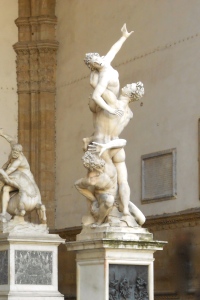Title: The Rape of the Sabine Women
Artist: Giambologna (Jean de Boulange)
Medium: Marble (Size not available)
Date: 1583
Location: Loggia dei Lanzi, Florence & Galleria Academia, Florence
Category: Women as Symbols of Sex and Fertility
Giambologna was an Italian-Flemish artist who lived from 1529 until 1608. He made major influences in Italian culture between the years 1550 and 1600 (“Giambologna (Giovanni da Bologna”). When approaching this sculpture, Giambologna attempted to use a method of intertwining the bodies in a serpentine style, because, “The spiral movement of figures in this Mannerist work anticipates Baroque sculpture… this too depicts a triumphant figure, a Roman who is sucessfully carrying off a Sabine woman” (Sullivan). This is one of the most technically perfect sculptures because of this formation and three individual bodies made out of one piece of marble. As one walks around the sculpture they begin to engage with the story of the piece.
This sculpture is a depiction of the Roman rape of the Sabines. Rape, in this period, refers to the wanton destruction of an area and robbing said area by using violence. This being said, one can see that a Roman man is abducting the Sabine woman. The Romans had been growing their empire, and they finally had reached a level of strength in their men. However, they lacked a female population, which meant that they needed to find women with whom they could procreate. Their neigbors, the Sabines, were not in any sort of alliance with the Romans because of their quick rise to prominence (Lefkowitz and Fant). The Romans attempted to marry Sabine women to continue their lineages, which the Sabine men were opposed to. According to tradition, Romulus invited the Sabines and other bordering peoples to a major religious festival. It was at this festival that the Sabine women were then abducted from their families and forced into helping to populate Rome (Lefkowitz and Fant). The Sabine woman can be classified as a symbol of sex and fertility simply by being a woman. To the Romans, the Sabine women were only worth the fact that they could produce children and carry on the Roman line.
“Giambologna (Giovanni da Bologna or Jean de Boulogne).” The J. Paul Getty Museum. J. Paul Getty Trust, n.d. Web. 18 Mar. 2015. <http://www.getty.edu/art/collection/artists/622/giambologna-giovanni-da-bologna-or-jean-de-boulogne-flemish-italo-flemish-1529-1608/>.
Lefkowitz, Mary R., and Maureen B. Fant. “233. The Rape of the Sabine women. Rome, traditionally 8th cent. B.C. (Livy, History of Rome 1.9. Late 1st cent. B.C.-early 1st cent. A.D. L).” Women’s Life in Greece and Rome. Johns Hopkins University Press, n.d. Web. 18 Mar. 2015. <http://www.stoa.org/diotima/anthology/wlgr/wlgr-privatelife233.shtml>.
Sullivan, Mary Ann. “Rape of the Sabine Women.” Loggia dei Lanzi. Mary Ann Sullivan, n.d. Web. 18 Mar. 2015. <http://www.bluffton.edu/~sullivanm/lanzi/lanzi2.html>.

